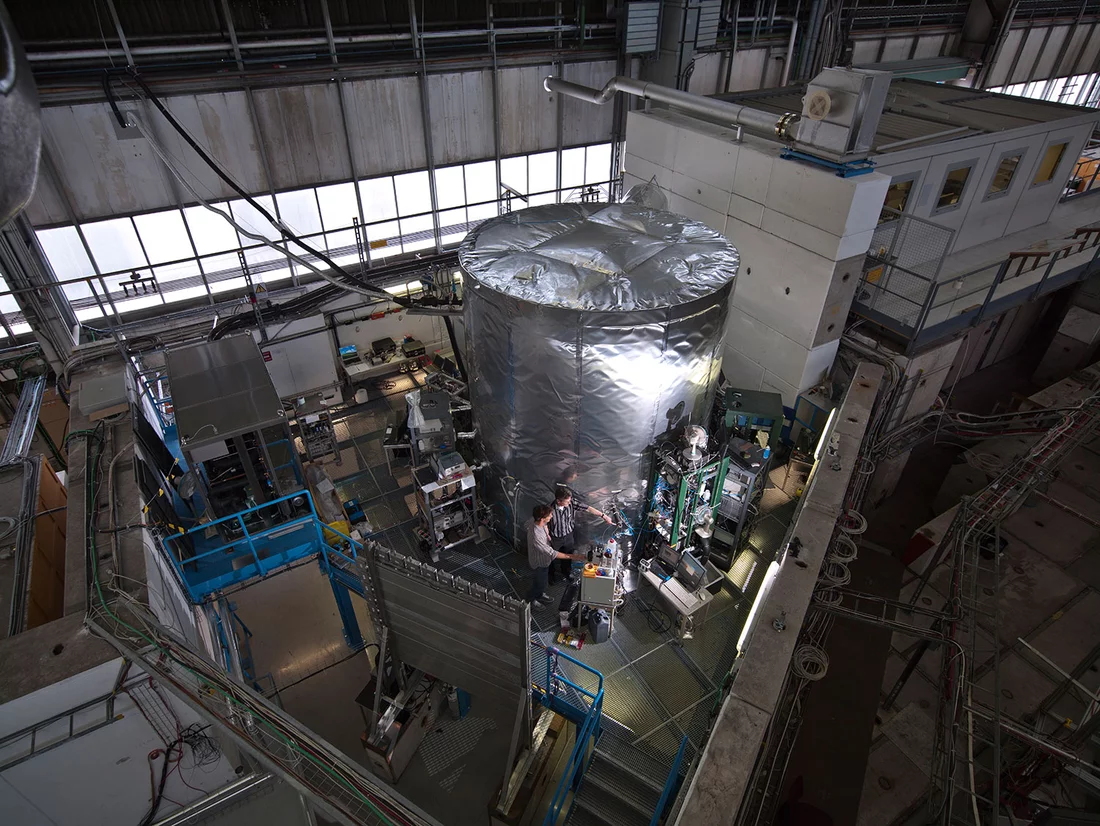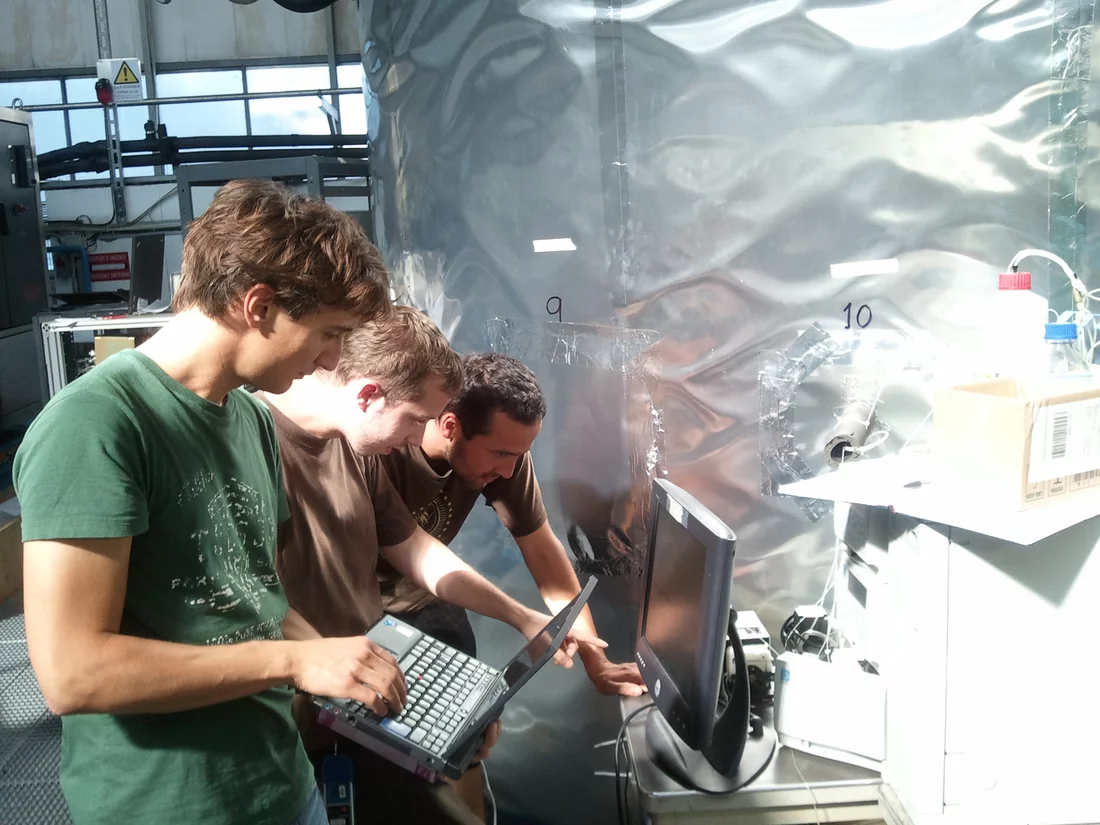Scientists know that clouds have a net cooling effect on our planet but the exact magnitude of that cooling effect is not exactly known. Furthermore, it is unclear how the effect of clouds on climate will change if the trend towards warming continues. In fact, the latest report of the Intergovernmental Panel on Climate Change (IPCC), once more pointed at clouds as the largest source of uncertainty in present climate models. A new study by the CLOUD experiment (Cosmics Leaving OUtdoor Droplets) at CERN sheds light on the very first step of cloud formation, thereby contributing to a better understanding of the cloud-climate connection. The study was led by scientists at the Paul Scherrer Institute (PSI) and was published on 16 May 2014 in the journal Science
A large share of the uncertainty concerning cloud effects on climate stems from the complexity of cloud formation. Cloud droplets form when water vapor in the atmosphere condenses, but the process requires the helping hand of cloud condensation nuclei. This is how scientists call the solid or liquid particles to which water vapor needs to attach before a cloud droplet is born. While the particles can be emitted directly from natural sources or human activity, most of them form only in the atmosphere from precursors emitted originally as gaseous pollutants.
This transformation of gases into solid or liquid particles – scientists call it nucleation – is the very first step on the road to most clouds. And it is the first source of questions. Scientists still don’t know what components are needed to make the particles stable and big enough, so that they can serve as “cloud seeds”. The new study now adds an indispensable ingredient to that long sought-after cloud formation recipe.
Sulfuric acid alone can’t do the job
In their quest for elucidating the cloud formation conundrum, scientists have already found a necessary ingredient: Sulfuric acid has been long known to play a key role in the process. Its concentration has been observed to correlate with the rate of new-particle formation, or nucleation. At the same time, however, sulfuric acid just seems to be one piece of the puzzle, as documented by the failure of theoretical efforts to explain nucleation rates as a consequence of sulfuric acid concentration alone.
The prominent role of sulfuric acid in nucleation is due to its low vapor pressure, i.e. its strong reluctance to evaporate. Individual molecules can only nucleate into particles if they first pile up into clusters big enough to prevent them from falling apart. But it turns out that even the sticky sulfuric acid molecules need an additional glue to hold the clusters together.
The new glue from the forest
The new study shows just how the gluing works. Clusters of sulfuric acid, the scientists observed, become more stable against evaporation and thus grow to a larger size and eventually nucleate, when they incorporate certain highly oxidized organic vapors of biological origin usually present in the atmosphere at extremely low concentrations. Specifically, the scientists produced these highly oxidized species from a doubly oxidized product of alpha-pinene, a molecule that gives pine forests their characteristic smell. Alpha-pinene is emitted by trees mainly during the warm season and is rapidly oxidized in the atmosphere.
When the scientists added sulfuric acid and this biogenic organic oxide to their chamber and let it further oxidize, they observed a dramatic rise in nucleation rates. Evidence that highly oxidized organic molecules were indeed involved in spawning that burst of nucleation was found by the scientists in two ways. One was experimental and consisted in precise mass spectrometry measurements from which the researchers inferred the presence of both sulfuric acid and organic oxides in the clusters. The other, theoretical, was provided by detailed quantum mechanical calculations showing that in fact a hybrid cluster is less likely to evaporate than a cluster containing only pure sulfuric acid.
Ions play a minor role
The scientists also tested an alternative route to enhance cluster stability and consequently promote nucleation. They examined if charged molecules (ions), which are produced in the atmosphere as a consequence of cosmic radiation, would provide a stronger glue than their neutral counterparts. Indeed, ions were observed to have a significant share in stabilizing the clusters, but they did so only when the concentrations of sulfuric acid and organic oxides were very low. Organic oxides and ions, it turns out, both contribute to providing the additional stability that sulfuric acid clusters need, with the neutral organic oxides being more important, as soon as their concentration and that of sulfuric acids surpass a certain threshold.
Better model predictions
After establishing the new mechanism of particle nucleation, the scientists incorporated it in a global aerosol formation model. They wanted to check whether the new mechanism would be able to describe the reality of nucleation and its seasonal variations correctly. And indeed: taking into account the stabilizing contribution of the organic oxides helped the model predict nucleation rates more accurately. The agreement with field measurements stood also the test of seasonal variation: the model was able to predict the typically observed ups and downs in nucleation in the course of a year. This latter test is a strong confirmation of the fundamental role of emissions from forests in the very first stage of cloud formation and that the new work may have succeeded in modeling that influence.
Experimenters and modelers join forces
Urs Baltensperger, head of the PSI Laboratory of Atmospheric Chemistry, calls the new results an important step towards understanding particle nucleation, the process at the origin of cloud formation. He remarks, however, that after particles nucleate they need to grow bigger, up to a size of 50 to 100 nanometers, in order to become cloud condensation nuclei. The new study hasn’t looked into that growth phase, so it would be premature to affirm that we now understand cloud formation as a whole. Furthermore, while the experiments reproduced a typical atmospheric setting they didn’t cover the complete range of possible meteorological conditions.
Baltensperger stresses, however, the importance of performing experiments in the precisely controlled environment of a chamber like that of the CLOUD experiment. With CLOUD we can change the concentrations of chemicals involved in nucleation and then measure the rate at which new particles are created with extreme precision. Also parameters like temperature, pressure and humidity can be easily changed at will. Such control on ambient conditions is virtually impossible to attain in field measurements. As important as experimental conditions, Baltensperger adds, is the involvement of modeling experts already in the design phase of the experiments. “Without their help our experiments would be much less effective at finding relevant answers, and we would certainly have difficulties in translating our results into the predictive power of models.”
Text: Paul Scherrer Institute/Leonid Leiva
About PSI
The Paul Scherrer Institute PSI develops, builds and operates large, complex research facilities and makes them available to the national and international research community. The institute's own key research priorities are in the fields of matter and materials, energy and environment and human health. PSI is committed to the training of future generations. Therefore about one quarter of our staff are post-docs, post-graduates or apprentices. Altogether PSI employs 1900 people, thus being the largest research institute in Switzerland. The annual budget amounts to approximately CHF 350 million.
Contact
Prof.Dr. Urs Baltensperger, Head of Laboratory of Atmospheric Chemistry,Paul Scherrer Institute,
Telephone: +41 56 310 24 08, E-mail: urs.baltensperger@psi.ch
Original Publication
Oxidation Products of Biogenic Emissions Contribute to Nucleation of Atmospheric ParticlesF. Riccobono et al.,
Science, 16 May 2014
DOI: 10.1126/science.1243527


